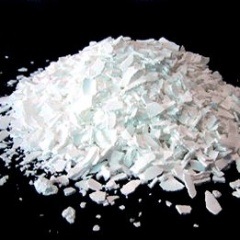Calcium Chloride
| Infobox on Calcium Chloride | |
|---|---|
| Example of Calcium Chloride |  |
| Facts | |
| Origin | - |
| Stowage factor (in m3/t) |
|
| Humidity / moisture | - |
| Ventilation | - |
| Risk factors | See text |
Calcium Chloride
Contents
Description
Calcium chloride (odourless, very hygroscopic, white, deliquescent crystals, granules, lumps or flakes), CaCl2, is a salt of calcium and chloride. It behaves as a typical ionic halide, and is solid at room temperature.
Calcium chloride can be produced directly from limestone, but large amounts are also produced as a byproduct of the Solvay soda and other processes.
Applications
Due to it's exothermic properties, ability to attract moisture from the air and surroundings and dissolve at a very low temperatures, Calcium Chloride is widely used in snow and ice melting, dust control, oil and gas drilling, moisture-absorbing, accelerator for concretes, etc.
Shipment / Storage
Because of its hygroscopic nature, anhydrous calcium chloride must be kept in tightly sealed, air-tight containers.
The product liquefies extremely readily, and unless well packed will absorb moisture from the air and become damp, wet or even dissolve in its own water of absorption. Can be dehydrated by heat, or sold as a solution, against depreciation.
Risk Factors
- Wetness
- Decomposes on heating at high temperature and on burning. This produces toxic and corrosive fumes. The solution in water is a weak base. Attacks zinc in the presence of water. This produces flammable/explosive gas (hydrogen). Dissolves violently in water with liberation of much heat.
- Consult applicable MSDS sheet(s)
- Reference is also made to the relevant IMO regulations on hazardous cargo.
See also: http://www.chemicalland21.com/industrialchem/inorganic/CALCIUM%20CHLORIDE.htm











